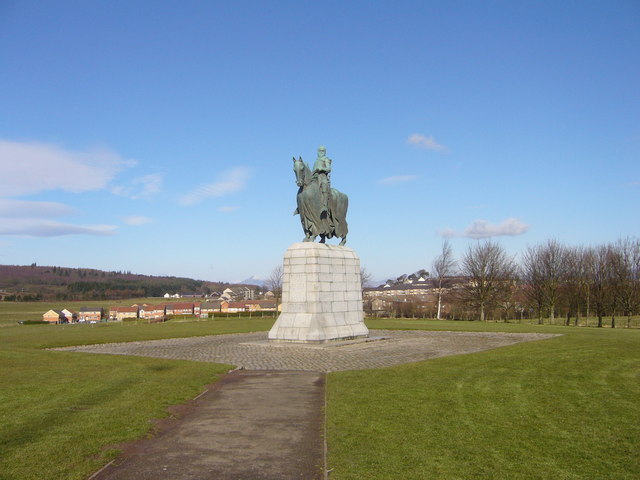The Bannockburn visitor’s center is on an open field. Looking out from the visitors center, to the south the field curves gently down into the Bannock Burn. In the north, there is the town, and St. Ninian’s church, and beyond St. Ninian’s there is Stirling Castle, high on a hill.
It is not Gettysburg, which has been marked by every faction as an ongoing battle over the memory of the American Civil War. It is not the beaches at Normandy, still marked by concrete bunkers. Its only markers are a statue of Robert the Bruce, and a memorial rotunda.

But, despite the lack of material, I remember this battlefield, and this visit. Because it taught the history with a game. After going through the museum, we were brought into a circular room, with a table on the centerpiece. The terrain of the battlefield was molded onto that table, and projected from above were banners of each of the lords leading troops on the battlefield. There, each of the people was given command of a few banners. It was my family, and as I remember one other. Archers, Infantry, Knights, and the Scottish side got Schiltrons. In that battle, my team was fairly passive, and so I ended up taking general command. In the battle itself, the English drove forward, smashing across the bridge on the Bannock Burn under the cover of a withering hail of arrows. While the Scottish defenders held, the battle was won, as a single unit of archers pounded Robert the Bruce’s formation until the man fell, riddled by clothyard shafts.
Unlike most battlefields, where we tell the stories of those long dead, there, we created a story of our own. A clearly ahistoric one, given that the Scottish suffered from a divided command, while the English were driven forward in a single minded assault, but a personal story. In reality, the English lost, decisively, and Scotland would remain its own country for centuries more.
Similarly, in Tecumseh Lies Here, the game is ahistoric. The setup, a shadowy conspiracy leading them to race through books and around historic sites is a staple of cyberpunk and television shows. However, at the same time, the key element of the game, getting participants to learn history by actually doing history, is something that has real, genuine educational value. However, it has its limitations. Especially the amount of work that goes into making a single shot experience. Throughout Timothy Compeau and Robert MacDougall’s account of the game, the piece that keeps cropping up is just how much work went into the experience, and how little success they had in adapting an ARG into something that could be replicated in classrooms across Ontario, let alone beyond it. The solution they found, turning it into a augmented reality experience, lacks the interactivity to really be called a game, at least in my opinion.
Offering more promise in crafting games to teach history are the Niagara and Queenston 1812 experiences. Rather than going into a comprehensive ARG, the games are smaller experiences, using digital technology to enhance physical locations, specifically allowing historic sites to put far more documentation and manuscripts into the hands of the people at the site than would be possible with conventional tools. How effective these AR tools are in actually teaching history, or creating historically engaged people is still questionable.
Overall, the position of games in teaching history is still open to contention. I believe the future is not so much in using games to teach the processes and methods of history, as it is in making history personal. Whether that be through a self contained experience as at Bannockburn, or the more open designs of Niagara and Queenston, games offer the ability to not just experience history as a passive observer, but to engage with the events, and tell the story on the player’s terms.
One reply on “History Games”
I agree, that making history personal is more important than teaching the public how historians study and analyze history. Although getting the public to understand how and why historians practice history is important, as it would gain more respect for the field and non-history major students would get more out of their history education.
I have also been to Bannockburn and they also had a section with different characters from different socio-economic backgrounds and genders at the time of the battle. The visitor stands on a marker and moves their arms around to choose different information to learn about the character, and how their perspective before Bannockburn.